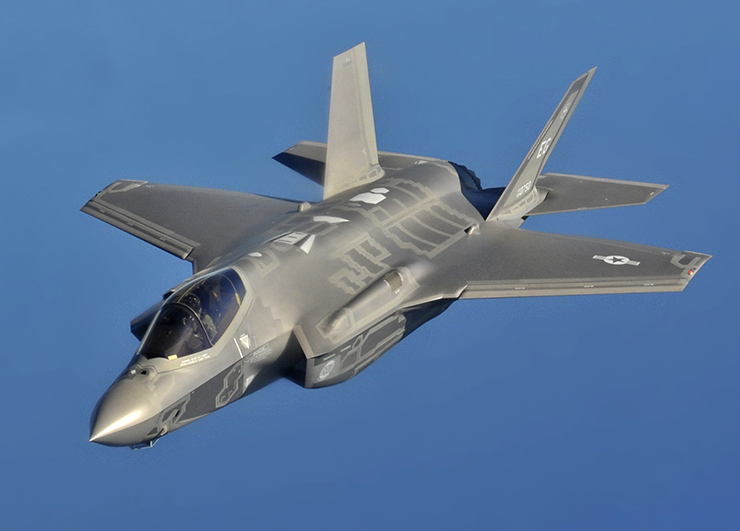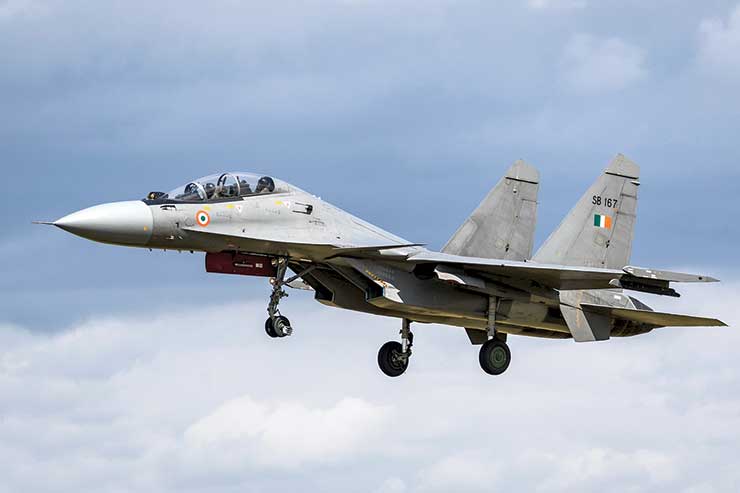
With the Americans bringing the F-35 stealth fighter and the F-21 (a rebadged F-16) to Aero India, there will be a deluge of articles in the media that India and the US are about to ink a high-octane deal. However, air show performances rarely translate into quick deals. Plus, at the moment the IAF is not looking at any of these aircraft because its primary air dominance requirement is being met by the Sukhoi Su-30MKI and two squadrons of the newly arrived French Rafales.
Codenamed Flanker by NATO, the Sukhoi forms the backbone of the Indian Air Force’s fighter fleet. With around 262 Sukhois currently in service, the Russian multirole aircraft comprises 36 per cent of India’s fighter fleet. It is one of the world’s most capable fighter-bombers and forms the spearhead of the IAF’s air dominance strategy.
The Sukhoi’s versatility – owing to its extended range, speed, firepower and super-manoeuvrability – has given the IAF considerable leeway in deploying the aircraft in offensive missions. The aircraft’s 3,000 km range and 4.5 hours combat endurance (which can be extended up to 10 hours through mid-air refuelling) make it perfect for providing air cover across India’s vast landmass and even beyond.
The February 2019 punitive attack on Pakistan showcased Sukhoi’s effectiveness. During the raid, 12 Sukhois provided top cover through combat air patrol (CAP) for the 10 Mirages that penetrated Pakistani airspace and bombed terrorist bases in Balakot. Had Pakistani jets attempted to intercept the Mirages, the Flankers would have blasted them out of the skies.
The Sukhoi’s range and large weapons payload also make it the ideal “swing” fighter capable of being fielded in a two-front war involving Pakistan and China. Sukhois have been stationed in bases across India – Pune, Maharashtra; Bhuj, Gujarat; Jodhpur, Rajasthan; Bhatinda and Halwara in Punjab; Sirsa, Haryana; Bareilly, Uttar Pradesh; Kalaikunda and Hashimara, West Bengal; and Chabua and Tezpur, Assam. The Sukhois, which arrived in Thanjavur in 2015, are perfectly positioned to strike at PLA Navy flotillas in the Indian Ocean. Plus, the Carnic airbase in the Andaman & Nicobar Islands has been configured for Sukhoi operations, allowing the IAF to target Chinese vessels as they pass through the narrow Malacca Straits.
The total of 262 Sukhois is an impressive strength for an expensive (₹420 crore) weapons platform. This shows a keen sense of judgement by the IAF, which realises that 100 per cent fleet utilisation is impossible and having a large number of aircraft around is the key to getting the job done. “These aircraft will be the high end of India’s air power, and can be expected to remain in the force past 2030, and are competitive with or superior to top-end European fighters and American F-15 variants,” says Defense Industry Daily.
End of the road
Due to its massive size (nearly twice the size of the American F-16), the Russian aircraft can be constantly modernised and re-fitted with the latest avionics, engines and radars. This has allowed the Flanker to remain at the frontline of military aviation for more than 45 years. But no amount of upgrades can keep an aircraft flying forever, and the Su-30MKI will start showing its age by the beginning of the coming decade. Around this time, the Chinese will have inducted their new stealth bomber, creating a new threat for India.
Another reason to look beyond Sukhoi is self-sufficiency. Dependence on foreign suppliers means India often gets arm-twisted and ultimately we end up paying whatever the vendor asks for.

In 2020, after the clashes in Ladakh, HAL was asked to restart the Sukhoi assembly line, but the plan was later deferred. In July 2020, the Defence Acquisition Council approved the procurement of 12 Su-30MKI aircraft from Russia to be licenced-produced by HAL at an estimated cost of ₹10,730 crore. These are meant to replace the Sukhois in the inventory that had crashed over the years. However, the project never took off because the Russians quoted a very high price. (This could well be a ruse by India and Russia to avoid Western sanctions, and production may happen under the radar.)
Still, the reality is that negotiation bottlenecks are routine when dealing with foreign vendors because they know India has limited options when it comes to acquiring modern weapons, especially fighter aircraft. With the country’s weapons procurement bureaucracy having a notorious reputation for stalling purchases, the time to start planning for the post-Flanker future is now.
Make in India
Currently, India has three options to fill in the fighter shortfall of around 12 squadrons (around 240 aircraft). One, accept Moscow’s terms and crank up the production of Sukhois. Two, import the cheap American F-21 or the unproven F-35. Three, speed up the development of the Tejas Mark II and the indigenous stealth fighter, the Advanced Medium Combat Aircraft (AMCA).
Options one and two will kill the nascent fighter aircraft industry that has risen miraculously from the scrap heap of numerous defunct Indian defence projects. India should no longer go back to the decades-old policy of running to Russia for jet fighters. Since the Russians are apparently unable to provide what the IAF wants, India should push harder on its own concurrent Tejas and AMCA programmes.
While the 36 new French Rafales together with the Sukhois will form the bulk of the IAF’s air superiority fleet, the IAF should aim for advanced versions of the Tejas to act as the bulk of its future fixed-wing fleet. India has ordered 40 Tejas Mark 1, 73 Tejas Mark 1A and 10 Tejas Mark 1A trainers. It plans to procure 324 Tejas aircraft in all variants, including the Tejas Mark 2 currently under development. The green light for the modern light combat aircraft will not only give a boost to India’s aeronautical industry, but also help fill the gaps in the IAF’s current fleet which is down to 30 squadrons or less.
At the same time, the IAF needs to make sure the AMCA does not travel the same trajectory as current stealth programmes. Instead of packing everything into one aircraft (as the Americans have done with the F-35), India must go for a practical aircraft with robust offensive and defensive capabilities, without too many bells and whistles. That is, the AMCA need not be the best stealth aircraft in the world; it just needs to get off the ground and become the starting point for India’s fifth-generation fighter programme.
Acquiring stealth capability is a priority in the backdrop of the rapid expansion of the Chinese PLA Air Force, which already has two concurrent fifth-generation fighter programmes – the J-20 which has entered full-scale production and the J-31 which is being developed for export to countries such as Pakistan. China is reportedly also developing a naval stealth jet which will have vertical take-off and landing (VTOL) capabilities for carrier operations. And by the early 2030s, the PLA Air Force could be test-flying a sixth-generation fighter.

Stealth aircraft are no longer a luxury. The IAF requires low-observable fighters to achieve air dominance in the heavily fortified air defence environments in India’s neighbourhood. Extended combat range, long-range standoff weapons, smart engines, stealth/low observable features and sensor fusion capabilities are needed to counter airborne and surface-based air defence systems that are being fielded by India’s adversaries. Precision attacks on high-value targets require stealth aircraft capable of sustained flight.
The biggest spinoff of successful projects is they create thriving industrial ecosystems. Like the BrahMos cruise missile, the Tejas project has also led to the establishment of a huge aerospace base in the country. It has created indigenous design expertise, design tools and test facilities. The programme has allowed the Aeronautical Development Agency, which designed the Tejas, to gain expertise in the processes of flight testing and certification, and in prototype development. According to the Agency, as many as 149 work centres in 28 cities across the country have contributed to the Tejas programme. These centres are now available for the AMCA project.
If large orders for the AMCA are assured, private Indian companies will also jump in, setting up new facilities across the country. The AMCA could follow the BrahMos model of private partnership to ensure accountability and freedom from sabotage.
Endgame
The IAF will be retiring its outdated MiG-21s and Jaguars in the near future; Mirages and MiG-29s will be retired in the medium term; and the Sukhois will fly into the sunset in the long term. This means the service will need hundreds of replacement fighters. If India does not plan out this transition in a neatly phased manner, it will be playing catch-up all over again in the 2030s.
The current shortfall of 12 fighter squadrons did not happen overnight – it is the result of two decades of flip-flops by the political leadership. Perhaps the biggest blunder was not licence-producing the Mirage-2000 – despite retaining an option to do so until June 1984 – and continuing to produce the outdated MiG-21. Geopolitical considerations played a role in that decision.
Modern aircraft have a technical life of around 25 years, which is extendable through midlife upgrades. Replacements have to be ordered years before the aircraft is likely to be retired or mothballed. While expanding and re-equipping its fleet, the IAF should have a basic rule – acquire the right mix of aircraft – in sufficient numbers – that can get the job done in the transformed battlespace of the Indian subcontinent.
–The writer is a globally cited defence analyst. His work has been published by leading think tanks, and quoted extensively in books on diplomacy, counter terrorism, warfare and economic development. The views expressed are personal and do not necessarily reflect the views of Raksha Anirveda








